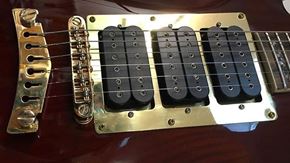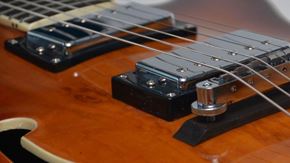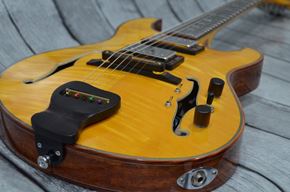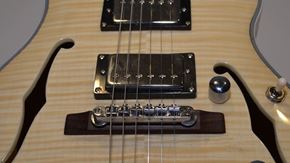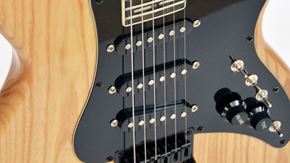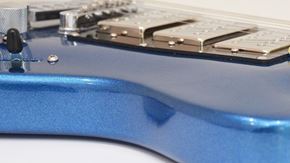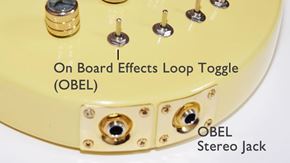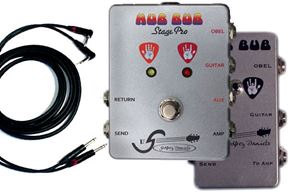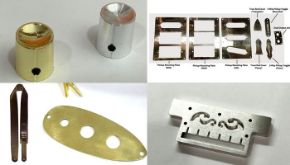A Brief History
The solid-body electric guitar is a rather modern instrument with a history that dates back to the around the 1920s. Preliminary experiments with magnetic pick-ups at the Gibson guitar factory enabled the natural sound of the acoustic guitar to be amplified through a speaker. However, there seemed to be a problem involving feedback in hollow bodied instruments that were equipped with a magnetic pick-up. Attempting to alleviate this dilemma, Adolph Rickenbacker developed the Rickenbacker “Frying Pan”.

"Frying Pan" by Rickenbacker
The “Frying Pan” owed a great deal to the popularity of Hawaiian music in America at the time. The Hawaiian guitar was basically a solo instrument played with a metal slide. The electric Hawaiian guitar built by Rickenbacker resembled a frying pan with an extended handle. There was a rather large pick-up at the bridge of the “Frying Pan” to pick-up string vibrations. This was considered one of the first solid-body electric guitars since it depended almost entirely on its sound being amplified electrically, rather than acoustically. In 1944, Leo Fender developed a new, smaller electric pick-up and implemented it onto a body similar to the “Frying Pan”--except the neck had a standard, properly fretted guitar fingerboard.
Meanwhile, Les Paul was working on something similar which he called “The Log”.

"The Log" by Les Paul
After hearing about a solid-body violin made by Thomas Edison, Les Paul felt that the only way to reduce feedback was to mount the pick-up on a solid piece of wood. By using a solid piece of wood, it increased the mass of the guitar body so that its ability to receive and transmit vibrations was reduced compared to a hollow bodied instrument.
Throughout the 1940s, 50s, and 60s, two principal companies, Gibson and Fender, developed enhancements to the solid body electric guitar. While working for Gibosn, Les Paul wanted the natural sustain of the guitar to be 20 seconds, without feedback. This led to the very heavy Gibson Les Paul guitar.

Les Paul by Gibson
Leo Fender, founder of Fender, desired a clearer distinct sound similar to that of the Hawaiian electric guitars. Fender’s Broadcaster guitar featured a detachable neck because he believed that the neck was the part of the guitar to most likely cause a problem and with a detachable neck, one could replace the neck to resolve the problem.

Fender Braodcaster
Around the 1960s, designs for magnetic pick-ups were now beginning to amplify and manipulate string vibrations more accurately. Consequently, in the 1970s, many guitar players consider the solid-body’s acoustic properties insignificant to its amplified sound. Guitarists assumed that tone was a function of pick-ups, hardware, and electronics, and added high-output pick-ups and heavy brass parts. At the time, the belief was that a heavy guitar had “better” tone.
In the 1980s, attitudes shifted, and guitarist recognized that a solid-body’s acoustic sound was the origin of its tone. Paul Reed Smith explained, “The electric guitar is an acoustic guitar, first and foremost. You’re taking something very small--the acoustic output of a solid-body—and amplifying it tremendously” (Guitar Player, p.50).
The remainder of this article will attempt to understand the electric guitar tone and how the instrument’s body, neck, bridge, scale length, and headstock interact in order to create the resonance which is then transferred to, and enhanced, by the magnetic pickups.
Wood Choices
The body of the guitar is usually made of wood, although other materials may be used such as plexiglass or plastic. The density and weight of a guitar body is proportional to its natural sustain. Although guitarists usually prefer a lightweight body because it is less strain on their shoulder and back, a denser body wood will generally have more sustain. The type of wood used is also critical to the guitar’s clarity, definition, and tone. Next we will look at some of the more widely used woods found in electric guitars today.

Maple Wood Body Blank
Maple wood, for example, provides a sharp pick attack with a quick decay time. The pick attack is how long it takes the string to reach its highest amplitude, or volume. A sharp pick attack means that this happens rather quickly. Maple wood usually generates a strong fundamental response without major overtone coloration, and is a fairly lightweight wood that produces good high-end response.

Honduran Mahogany Body Blank
Mahogany wood originates from many parts of the world and provides a warm round tone with more overtones, or harmonics, than maple. It is a dense and moderately heavy wood with a smooth attack and rich sustain. However, if the mahogany is extremely heavy, it tends to lose some of that warm round tone. Combining a mahogany body with a maple neck, as in the PHRED instruments DeadBolt, provides a lighter weight guitar with good high-end reproduction.

Swamp Ash Body Blank
Swamp Ash wood is a comparably lightweight American wood with a distinct ringing tone. Medium weight swamp-ash bodies have a sharp pick attack and very good tonal balance and sustain. Extremely lightweight swamp-ash bodies have a weak low frequency response and a thin sound characterized by an increased high frequency response.

Alder Body Blank
Alder wood is becoming more commonly used these days because its tonal characteristic can be used in a broad range of musical styles. It has a moderate attack with a smooth decay. These features give the guitar an even balanced tone identified by a well-defined low frequency response and clear high frequency response.

Basswood Body Blank
Basswood is another type of wood being used for guitars to give them loud, high-gain properties. It is an extremely dense wood, which provides for a flat, smooth frequency response. The pick attack is moderate and the sustain is smooth and linear.
Neck Attachment
The way a guitar neck attaches to the guitar body shapes the sound, as some of the strings’ vibration transfer to the body through the neck-body joint.

Bolt-on Neck Joint
Bolt-on necks, as on the PHRED instruments Stratus Custom Shop, are attached to the guitar body by four or five screws. The way this neck fits into the body is critical in the transfer of string vibration. There is a pocket routed out of the top of the body for the neck to be placed. If there are any gaps between the neck and the body within this pocket, there will be a loss in transferred sound. When the neck is fitted properly, certain frequencies are transferred better than others are. A bolt-on neck has an identifiable tone described as a twanginess sound. By putting the neck in a pocket and securing it with screws creates different kinds of stresses than filling the body-neck joint with glue.

Set-in Neck
A set-in neck construction describes this method of gluing the neck onto the body, which is how nearly all of PHRED instruments guitar are constructed. Many guitar players feel that a set-in neck gives the guitar a vocal quality where notes seem to swell after the pick attack until they reach their final loudness. Depending on the body, set-in neck tend to contribute a smooth, linear sustain with moderate pick attack.

Neck-Through-Body
Another type of neck construction is the neck-through-body construction. This means that the neck section is one piece of wood from the headstock to the guitar-strap button, similar to the log guitar built by Les Paul. There are small wing sections attached to the body section to give the guitar a usual shape. The neck through section is usually made of maple, but other woods, and combinations of woods can be used as well. In the case of a maple neck-through-body, it has most of the same tonal properties of a maple body. The small body wings, unfortunately, never get to develop the lower frequencies that a separate body and neck may produce. In a neck-through-body, the fundamental is often enhanced with few overtones, typified by a high frequency response, and thin sound. There are some neck-through-bodies that use a mahogany section to amplify the lower frequencies more than a maple neck would.
The Bridge
The bridge affects the guitar tone depending on how it joins the strings to the guitar body. 
Non-Tremolo Fixed Bridge
Tune-o-Matic Fixed Bridge
A fixed bridge is in direct contact with the guitar body and is mounted with screws to the top of the body. String vibration transfers directly from the bridge to the body. 
Tremolo Bridge
A tremolo bridge has the advantage of allowing the pitch of a note to be altered after the string is plucked. Tremolo bridges are attached through posts or screws threaded into the body. This means that string vibrations transfer to the body through a very small contact area. Usually, certain low frequencies are lost in the transfer. A fixed bridge usually sounds deeper and more uninterrupted than a tremolo unit. It will generally have a louder response in the low frequencies than a tremolo unit.

Scale Length
The scale length is the distance from the bridge to the nut at the top of the neck. The two tradition scale lengths for guitar are 24¾ inch and 25½ inch. Usually, bolt-on necks use 25½ inch scale length while set-in necks use 24¾ inch scale length. PHRED instruments guitars use a 25½ inch scale length with a set-in neck, the best of both worlds. These scale lengths not only determine fret spacing on the neck, but also influence the guitar’s overall timbre. Fret spacing is based on the equal temperament system where each semitone interval corresponds to a ratio of 1.05946, about 18:17. This leads to the rule of eighteen, which states that each fret should be placed 1/18 of the remaining distance to the bridge. However, there is a .06 percent discrepancy between 18:17 (1.05882) and 1.05946, which results in the octaves being 12 cents flat and noticeable to the ears. For the best tuning, the exact figure 17.817 should replace 18, or each fret should be placed 0.05613 of the remaining distance to the bridge. If the scale length is 24¾, the first fret should be place at 24.75 x 0.05613=1.389 inches from the nut.
As a result of a 24¾ inch scale, the same string will require less tension to produce the same frequency on a 25½ inch scale. This difference in tension results in the difference in timbre. A vibrating string on a 24¾ inch scale will sound warm with a midrange frequency boost. The same string on a 25½ inch scale will have a more distinct low frequency response with a bell-like clarity in the high frequencies.
Headstock
Just above the nut is the headstock. The headstock houses the tuning machines used to tune the strings to their relative pitches. There are two main type of headstocks-either flat or tilt back. 
Flat Headstock Design (PHRED instruments Stratus Custom Shop)
Flat headstocks, as found on Strat guitars, are essentially a continuation of the neck itself. There is little down-pressure on the strings at the nut which creates a characteristically “open” sound. Some of the lighter and brighter tones of a flat headstock guitar can be attributed to the vibration of the strings and headstock behind the nut. 
Tilt-back Headstock Design
In a tilt-back headstock, there is more down-pressure over the nut which contributes to increased sustain. Instead of the strings’ vibrations decaying through the headstock, more string vibration transfers into the body.
Putting it all together
Once we understand how the major components work individually, we can examine a particular guitar’s specifications and have a good idea of how it will sound without playing it. The PHRED instruments DeadBolt features a Mahogany body, set-in neck, 25½ inch scale length, fixed tune-o-matic bridge, and tilt-back headstock. The Mahogany body will have a warm round tone with a smooth attack and rich sustain. The set-in maple neck will add smooth, linear sustain with moderate pick attack. The 25½ inch scale length will provide a clear low frequency response with a bell like high frequency response. The fixed tune-o-matic bridge will have a loud response in the low frequencies. The tilt-back headstock will contribute to increased sustain as more of the string vibrations transfer into the body.
Magnetic Pickups
There are two main types of magnetic pickups, single-coil and humbuckers. Without going into too much detail on how they work, humbucker pickups have a higher output, less high frequency response, and are richer in overtones than single coil pickups. Generally, Fender guitars use single coil pickups because they agree with the guitar’s natural tone better than humbuckers, which are regularly found in Gibson guitars for the same reason. The location of the pickup along the vibrating string determines which mode of vibration will be amplified. The pickup close to the bridge will exaggerate the higher harmonics generated by the vibrating string. The pickup close to the neck will exaggerate the fundamental frequency generated by the string. Any pickup in the middle will exaggerate something in between the two. Usually there is a selector switch for certain pickup configurations.
Additional Electronics
Tone controls can further modify the signal from the pickups. They consist of a special type of resistor, caller a potentiometer, and a capacitor. The higher the value of the capacitor, the more high frequencies it will ground. With the tone control fully open, the output of the pickup is not altered. With the tone control turned down a little, it sends some of the signal to the grounded capacitor. As a result, high frequencies are attenuated. The amount of the signal sent to the capacitor is determined by the relative setting of the potentiometer.
Conclusion
In conclusion, the electric guitar’s sound is the sum of all its parts. Other factors such as fingerboard material, tuning machine material, nut material, and the guitar finish slightly alter the guitar’s sound. Nevertheless, the principal parts discussed above have a more important influence on its sound. These principle differences are noticeable to a trained ear. One can detect the note-for-note clarity of a bolt-on-neck guitar with single-coil pickups, or the muddy, bluesy, sound of a neck-through guitar equipped with humbucker pickups. Both are suitable for all styles of music.
References
Lasner, Rich. “The Quest for Ultimate Tone”, Guitar Player Magazine, February 1992:pp49-67.
Denyer, Ralph. “Electric Guitars”, The Guitar Handbook, 1982: pp.49-59.
Rossing, Thomas D. The Science of Soud. New York: Addison-Wesley, 1990.

